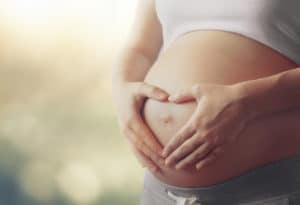Inguinal hernia in babies is congenital. This condition is not life-threatening at first, but it does require surgery. This is because the hernia does not close on its own. You can recognize a hernia in a baby by a soft bulge in the groin, the pubic area, or the scrotum.
Boys are more often affected by a hernia than girls. It can range in size from a marble to an egg. Learn everything about the topic of inguinal hernia.
Table of contents
Inguinal Hernia In A Baby – A Serious Matter
Normally, the intestine slides back into the abdominal cavity on its own. Then your baby will not have any pain. If the intestine comes out, your baby may feel pain. If your baby becomes restless, cries persistently, refuses food, or the bump shows any coloration, you must go to the hospital.
In this case, the intestine may be obstructed. As a result, it is no longer supplied with blood properly. An inflammation develops, possibly the intestine ruptures and the intestinal contents flow into the abdominal cavity. In this case, your baby will need surgery immediately.
Usually, you can plan the hernia surgery for your baby a few weeks in advance. Inguinal hernia surgery is a routine procedure and has few complications. There are different methods, by which this article informs you.
In most cases, your baby will be operated on under general anesthesia. Many operations are performed on an outpatient basis, so you do not have to go to the hospital. If your baby is younger than six months, you will go to the hospital. After two to three days, you can go home with your baby.
You usually discover a hernia when you are changing your baby’s diaper. Suddenly there is a small bulge in the groin that was not there before. Your baby keeps on kicking. Is this bump worrisome?
When should you see a doctor and what happens next if your baby does have a hernia? This article describes in detail the appearance and development of an inguinal hernia, as well as how to treat it.
Is The Inguinal Hernia In The Baby Dangerous?
If you discover a baby inguinal hernia, you don’t have to worry much at first. As long as the hernia disappears, everything is fine. The bottom line is that you will need to have your baby operated on for a hernia. The openings do not close by themselves.
If your baby has a hernia, you should take your baby to the pediatrician. He will discuss the further procedure with you and give you tips on how to deal with a hernia in a baby.
What Does A Hernia Look Like?
Inguinal hernia in babies affects about five percent of all newborns. Parents often notice a small swelling in the groin area when diapering or bathing their baby. In boys, the bulges may also show on the scrotum. In girls, the baby’s hernia may extend from the groin to the labia.
How big the bulge does not matter. There are small inguinal hernias in babies that only show bulges the size of a marble. Others cause bumps as large as an egg. You should not try to push the bump away. Doing so could further injure your baby.
The bulge can disappear as quickly as it came. It only appears with physical exertion, sneezing, coughing, heavy pressing during bowel movements, or pressure on the abdomen.
Congenital inguinal hernia occurs in about half of babies in the first year of life. In others, the hernia goes undetected for many years. This is because a hernia in a baby does not always cause pain.
Whereas it is very difficult to judge whether a baby is in pain or not. Adults report that a hernia causes a vague feeling of pressure or pulling. Because the baby’s hernia usually comes in phases, your baby may have pain when the bump is there.
If the bump is not seen, your baby is pain-free. If parts of the intestine are trapped or it is difficult for the intestinal contents to pass through this area, the pain will be greater.
Where Is There Increased Risk For An Inguinal Hernia?
- Prematurity
- Genetic makeup (if mother or father had an inguinal hernia as a baby).
- Children with urologic problems (such as undescended testicles).
Does An Inguinal Hernia Affect Boys And Girls?
Yes, both boys and girls can suffer from an inguinal hernia as a baby. However, boys are four times more likely to be affected than girls. This is because the hernia in babies is not a hernia in the true sense as it is in adults.
Hernia in babies is more of an opening of ducts that do not close properly during embryonic development. In boys, the testes move from the abdomen through the inguinal canal into the scrotum during the seventh month of pregnancy.
In doing so, they pull some peritoneum (the inner lining of the abdominal wall) into the canal. This canal usually closes on its own shortly after birth or within the first year of life.
Then the tube sclerosis and the scrotum are separated from the abdominal cavity. If this does not happen, a so-called hernia sac develops. This area remains open. A piece of the intestine can slip through the hernia sac, which shows up on the outside as a soft bump.
In girls, a tube of peritoneum also forms as an inguinal canal. It contains a uterine ligament. However, this closes much earlier than in boys. Therefore, premature babies have a particularly high risk of suffering from a hernia.
About 25 percent of premature babies are born with a hernia. In girls, in addition to intestines, an ovary can also slip into the hernia sac.
Is Hernia Caused By Crying?
No. Crying often causes internal organs to push into the hernia. This may appear as if the hernia is caused by strained crying. However, the hernia is already there.
In addition to the true inguinal hernia, in which internal organs push outward, there is also the water hernia (medical term: hydrocele). In this case, fluid simply collects around the testicle or the spermatic cord. A hydrocele, like an umbilical hernia, often grows by itself. It does not require urgent surgery.
Treatment Of The Hernia
Hernia in the baby needs to be operated on promptly to prevent further complications.
As long as your baby is not in pain, everything is fine. If you notice that your baby is in pain and a bump has appeared, you can carefully milk out the intestine. Your pediatrician should show you how to do this correctly. This procedure requires good nerves of steel.
After all, your baby is crying and you don’t know if you are hurting her/him even more. Very often driving a car helps. The jerky motion and the sitting position relax the abdominal wall and the bowel slides back on its own. Bad roads have something good in this case.
You usually notice when your baby becomes calmer and stops crying. This is also the reason why excited parents go to the pediatrician with a freshly discovered hernia and then are amazed to find that the bump is no longer there.
The Operation Of The Inguinal Hernia In The Baby
Usually, you can schedule the inguinal hernia surgery. When the surgery takes place depends on a few factors.
- Is your baby healthy or does he have neonatal jaundice, for example?
- Is your baby of normal weight or underweight?
- Are your baby’s blood counts correct?
If your baby is completely healthy, you should have hernia surgery soon. This minimizes the risk of your baby becoming an emergency. Get advice from your pediatrician and the doctors at the hospital.
For many babies, hernia surgery can be performed on an outpatient basis. You and your baby will not be admitted to the hospital as inpatients. If your baby is younger than six months, the surgery will be performed as an inpatient. This means that your baby will be well cared for and monitored.
Surgery is the most common procedure performed on babies and children up to 15 years of age. The procedure takes about 20 to 30 minutes. Complications are rare. However, every 10th child suffers another inguinal hernia in the same place after the operation.
During the operation, the doctors close the passage of the intestines. The hernia sac is detached from the vas deferens in boys and the uterine ligament in girls. Then it is removed and closed with a suture. The procedure is low-risk.
In babies, the mesh is not usually used to stabilize the tissue, as is used in adults. In children, no foreign body should be inserted that could hinder growth later.
If the hernia from the baby is not large, some doctors use laparoscopy. In this procedure, several small incisions in the abdominal wall are enough to guide a camera and surgical instruments into the abdominal cavity.
If the hernia is bilateral, this minimally invasive method can be used to operate on both hernias at once.
Other physicians argue that the benefits of laparoscopy in small patients do not outweigh the increased complication rate.
They traditionally operate with an open approach to the abdomen through a skin incision in the abdominal wall. The incision is made in the fold of the abdominal wall, so the scar is not very noticeable later. In the case of a bilateral inguinal hernia from the baby, surgery must be performed on both sides.
This is done in one session. The operating doctor decides which method is the most appropriate.
Anesthesia
With both methods, your baby will be under general anesthesia. Spinal anesthesia, i.e. local anesthesia, is rarely used. Before the anesthesia, your baby must be fasting. Most hospitals state that your baby must be fasting six hours before hernia surgery.
This can be quite hard on infants and you if your baby drinks frequently. Even if your baby cries, be sure to keep the fasting time. It is a protection for your baby. If you are breastfeeding, it can help if the dad takes the baby and comforts him. Then your baby won’t smell the breast milk and will be easier to soothe.
Emergency – Hernia Surgery
If your baby is in pain, cries continuously, vomits, or is very restless and the intestine does not slide back into the abdomen, you need to go to the hospital. Also, if the hernia is clearly discolored (purple, red, or blue) or your baby is refusing food, you need to go to the hospital urgently.
It is possible that the intestine is blocked. As a result, it may not get enough blood supply and may die. This situation is life-threatening. Your baby must be operated on within six hours. In this case, you should go to the nearest hospital immediately.
How Long Will Your Baby Stay In The Hospital?
Normally, babies are recovered a few hours after the laparoscopy. If you have an outpatient operation, you and your baby can go home. You must not leave your baby alone for 24 hours.
If your baby has had major hernia surgery or has been admitted to the hospital as an inpatient, he or she may be able to leave the hospital the next day.
However, a stay of two to three days after surgery will ensure the exclusion of post-operative bleeding and the overhang of medication after-effects. If in doubt, it is better to stay in the hospital with your baby a little longer.
Babies and especially children should rest for ten days and, if possible, not do any sports for two weeks. If your baby develops a fever or if the scar becomes red or swollen, you should consult a doctor.
Wounds in the skin heal between a few days and two weeks, depending on their size. You should change the wound dressing according to the doctor’s instructions. It may be necessary to remove the stitches after a few days.
You should not bathe your baby until the wounds have healed. After the operation, you will probably notice that your baby is behaving as usual. It will kick and move according to its age.
Sources
https://www.kinderaerzte-im-netz.de/krankheiten/leistenbruch-inguinalhernie-lat-hernia-inguinalis/










